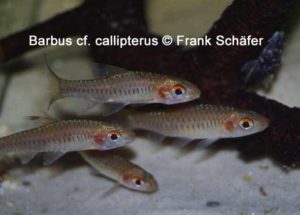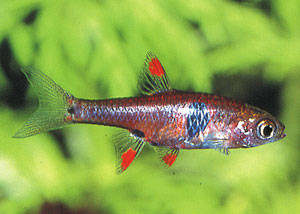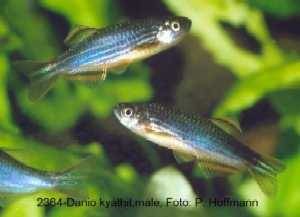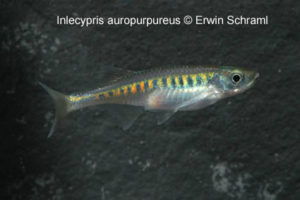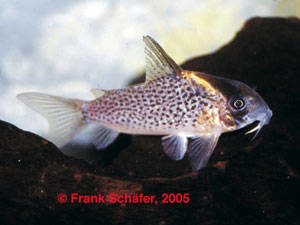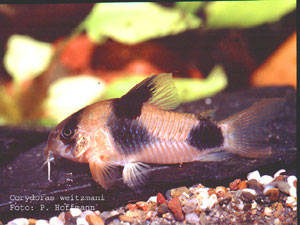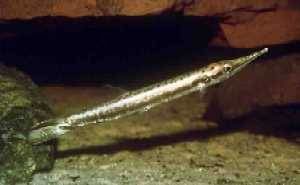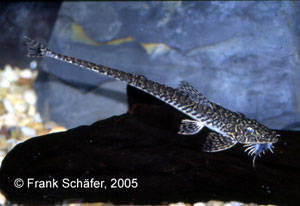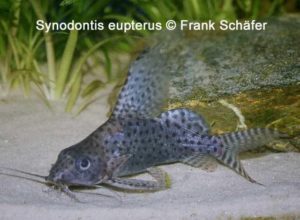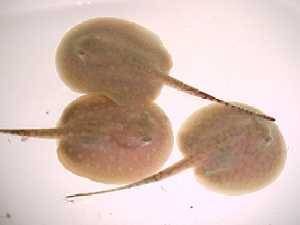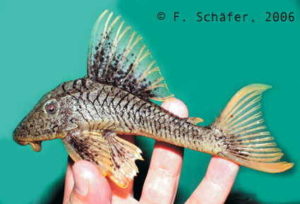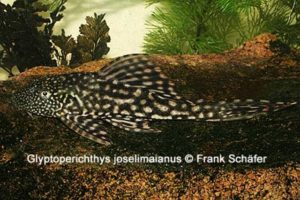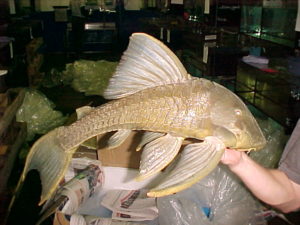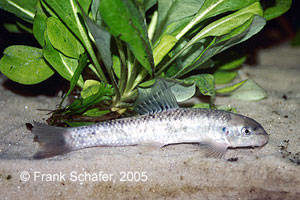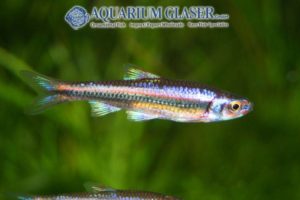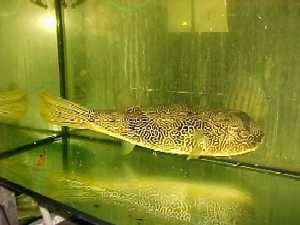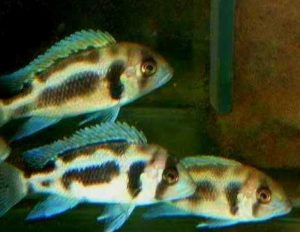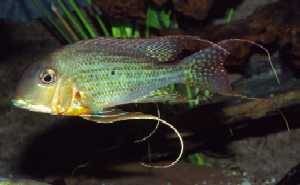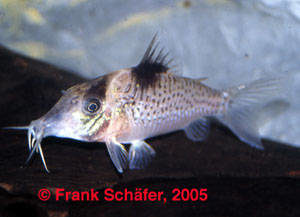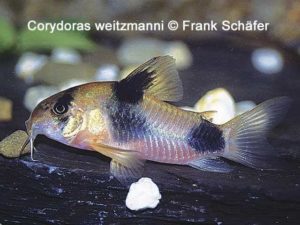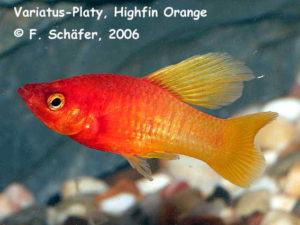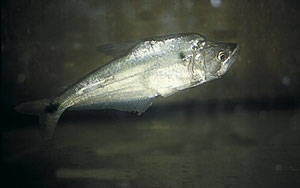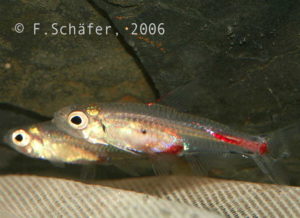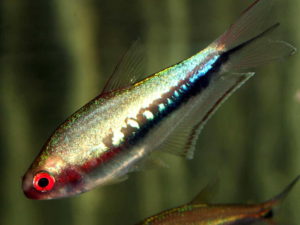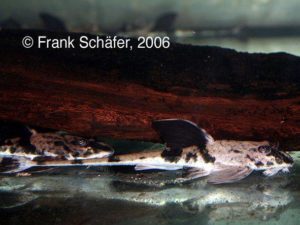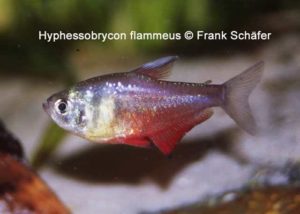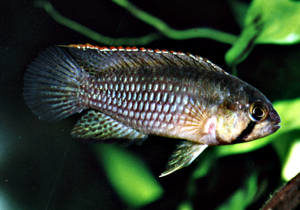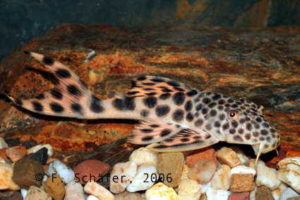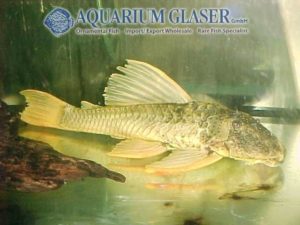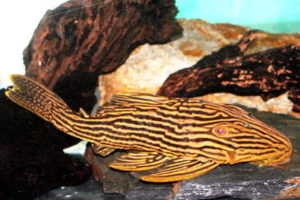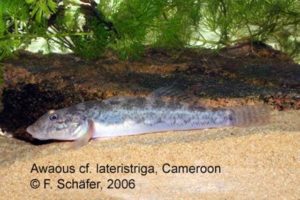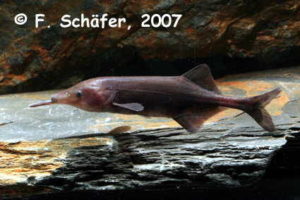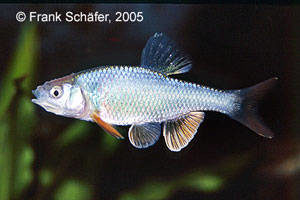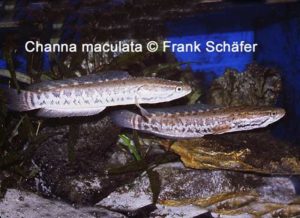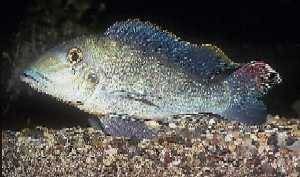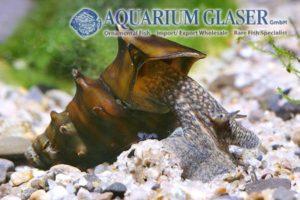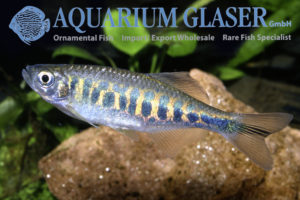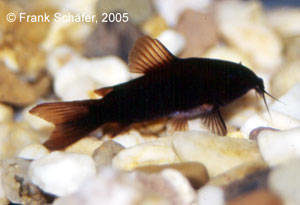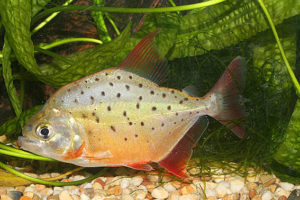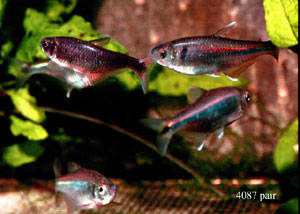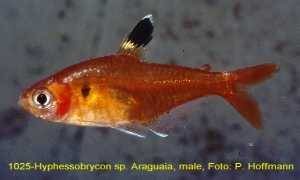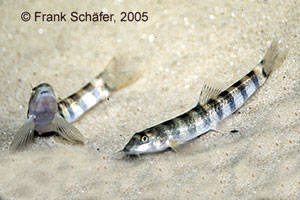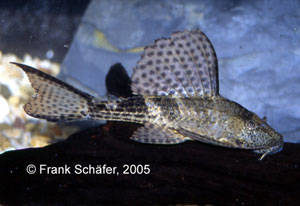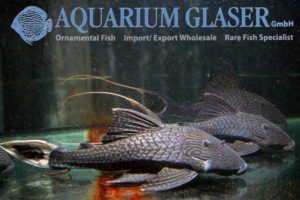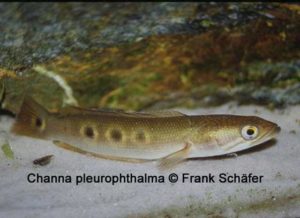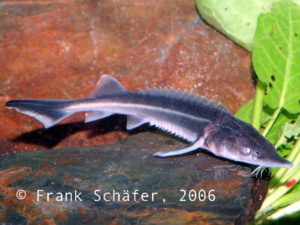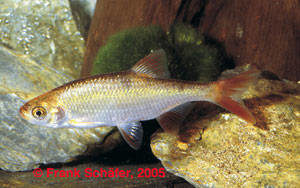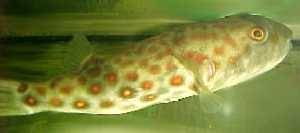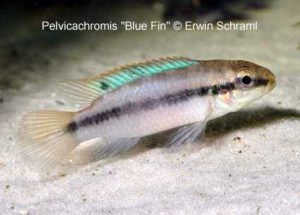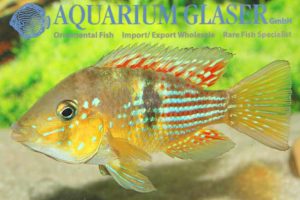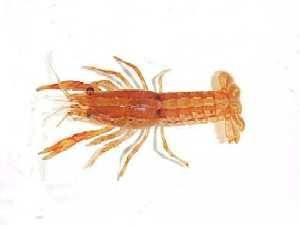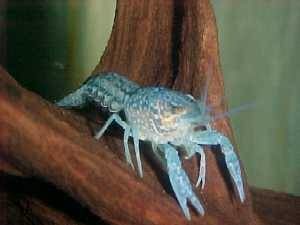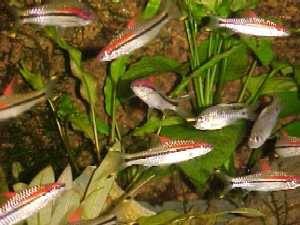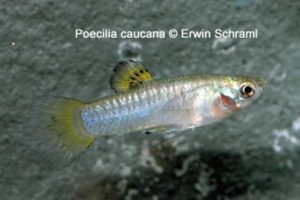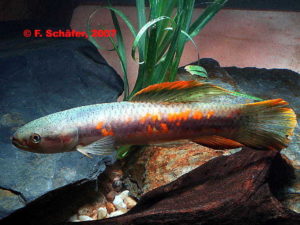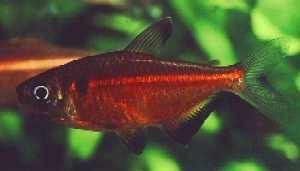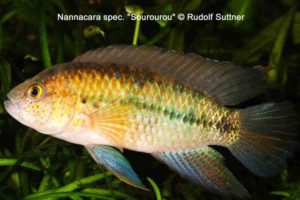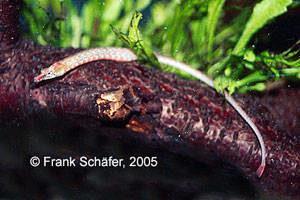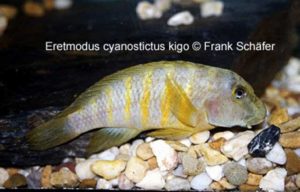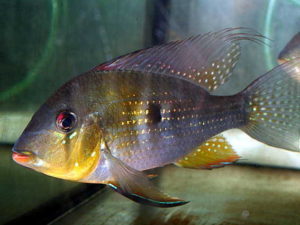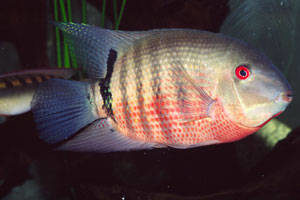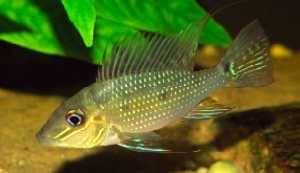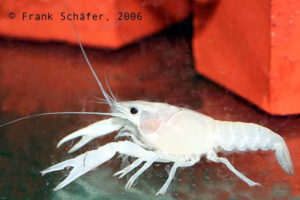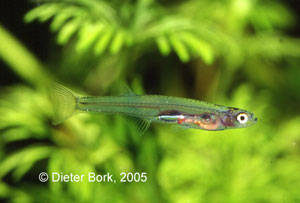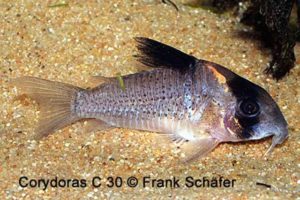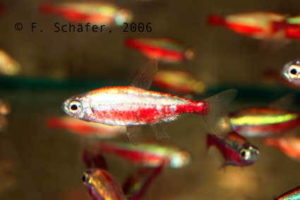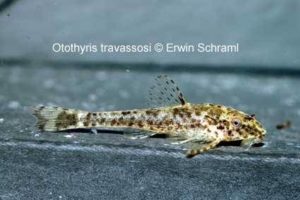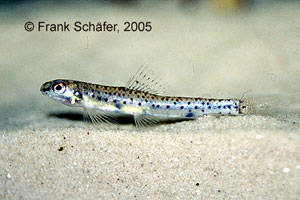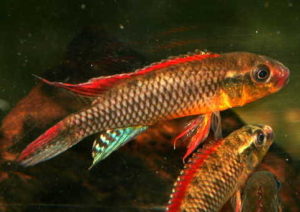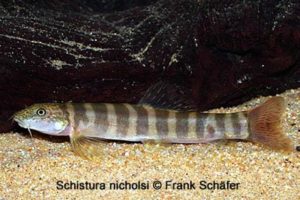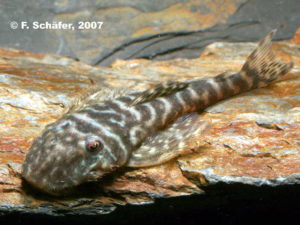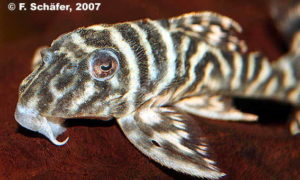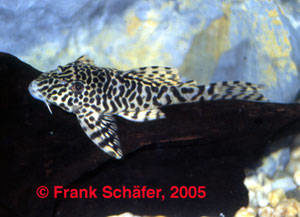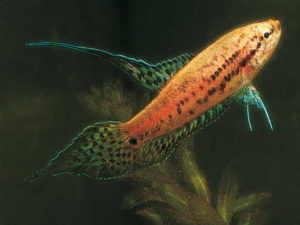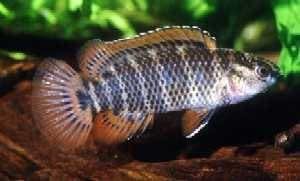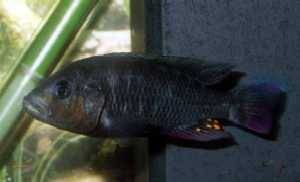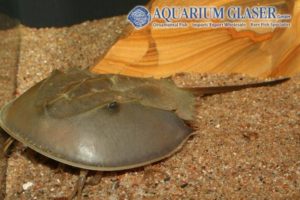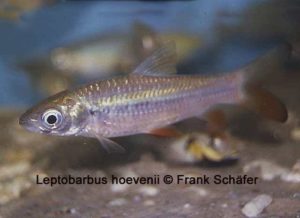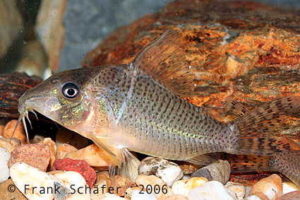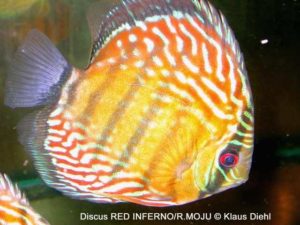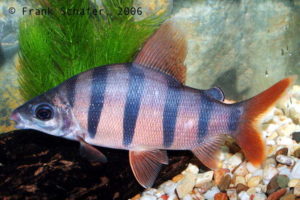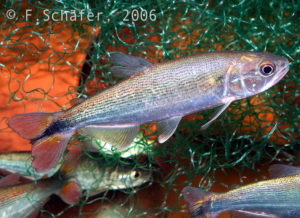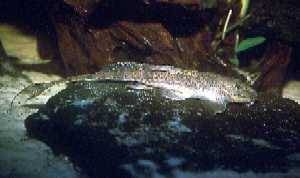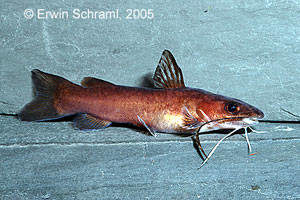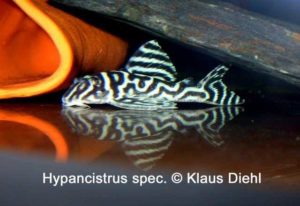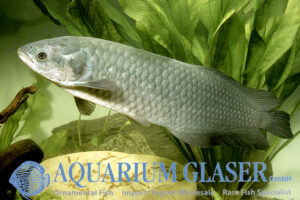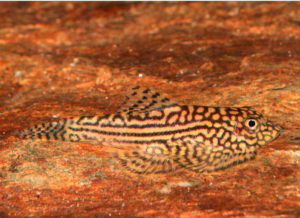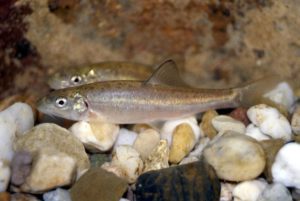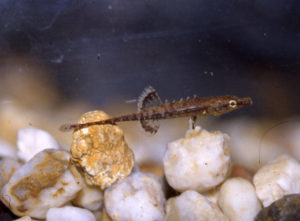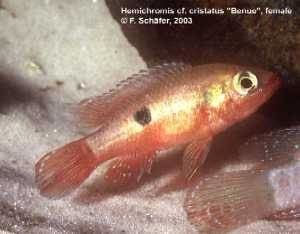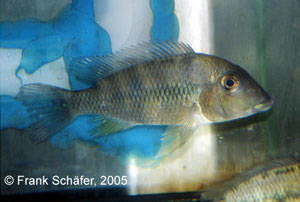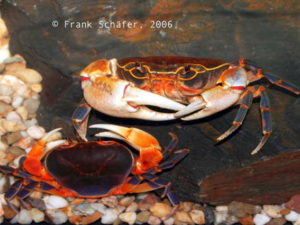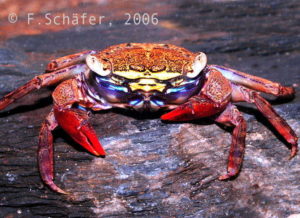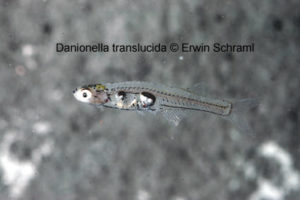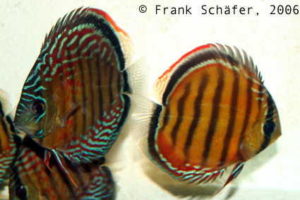This strongly at Barbus callipterus reminding barb reached us from the tropical west Africa. Whether it is a variant of the Clipper barb B. callipterus or a near related species could yet not be clarified. The further information refers to the general maintenance conditions of bigger barb species.They are social swarm fish, which should be […]
Fish Archive (2963)
-
-
Boraras cf. micros
THE SPECIES HAS BEEN DESCRIBED SCIENTIFICALLY IN THE MEANTIME UNDER THE NAME OF BORARAS NAEVUS. PLEASE CHECK THE FOLLOWING PAGE: http://www.aquariumglaser.de/en/boraras-naevus_de_1397.html This scientifically undescribed dwarf fish was imported from Singapore. They have very bright coloration and will not outgrow 1.5 cm in length. Like all Boraras dwarfs these fish need a special aquarium on their […]
-
Danio kyathit
The Burma-leopard-Danio, Danio kyathit, (“Kyathit”, burmese for leopard) belongs to the many minnows, which came to Europe in a bigger number of pieces lately. We first saw this beautiful “new” Danio in the beginning of 2002 at AQUARIUM GLASER. In contrast to Danio rerio Daniokyathit is much more colourful. Both sexes show intensive orange-red, beautifully […]
-
Inlecypris auropurpureus
Inlecypris auropurpureus belongs to in Inlé lake in Myanmar occurring endemic fish species. That about 6 cm long becoming swarm fish should be held in well planted to not too small (80cm) tanks. Since they are good jumpers, young animals of 1,5cm length can already jump over 10cm high, the tanks have to be completely […]
-
Corydoras sp. aff. kanei
This new and undescribed true mailed catfish differs from C. kanei by a golden band on the shoulder. The very attractive fish originate from the Rio Jamaxin (Brazil). Their final length is 5 cm. C. kanei has been bred successfully on several occasions and Seuß (Die faszinierende Welt der Corydoras, Landbuch Verlag Germany, 1997) reports […]
-
Corydoras weitzmani
This is one of the most spectacular representative of the Corydoras genus recently imported. For us this is the ultimate Corydoras. Its closest relative is probably Corydoras panda. The body pattern is similar to the recently described Corydoras tukano. This species was caught by the authors in September 2004 in the riverine system of the […]
-
Boulengerella sp. aff. lucius
Especially at the juvenile stage there seem to exist different colour variants of Boulengerella lucius. And it is doubtful if it really is Boulengerella lucius, which is why also this kind is being offered as B. sp. aff. lucius. This form of pike imported from Peru does not distinguish in the care, so tanks with […]
-
Crossoloricaria cf cephalaspis
The 5 species of the genus Crossoloricaria are all looking very similar to the flounder Loricariid genus Pseudohemiodon. These fish have as well a flattened body form, small eyes lying distally on the triangularly formed head. The difference between these two genii is the missing of the ventral bony plates of Crossoloricaria. Only at the […]
-
Synodontis eupterus
-
stingray-babies
July 2005: During the night from Sunday to Monday it was about time: We got three babies. About five weeks ago we had received a female from Pantanal River and we immediately noticed on arrival that this fish was not alone: It was pregnant. After five weeks now of intensive care, these three babies were […]
-
Cochliodon spec. var. marbled L 360a
From the drainage basin of the Tapajos arrived a new, until now not imported loricariid catfish at our facility. Body form and yellow fin seams remind strongly of L 360, the body and parts of the fins however exhibit a veining atypical for L 360. In their maintenance requirements they might probably not differ from […]
-
Glyptoperichthys joselimaianus L 1, L 22
Glyptoperichthys joselimaianus the “White Spot – Glycopterichthys” originates from the Rio Araguaia, one of the main tributaries of the Rio Tocantins in Brazil. There it inhabits different habitats, it was found e.g. on deadwood and also on flooded meadows. Natural water conditions (white water) do not have to be copied for maintenance, L 1 are […]
-
Panaque spec.
June 2006: Just freshly arrived! Also for „old stagers“ there are again and again genuine surprises with us. In a shipment from Peru we received today several particularly delicate Loricariids, which represent a petite alternative to the frequently maintained Hypancistrus species. However their size of (50 – 70 cm) probably exceeds the possibilities of most […]
-
Garra rufa
In the aquarium literature this fish species is known as “reddish suction-barbel” but in recent publication it has named “Kangalfish”. This plain looking fish is known for its use in the biological therapy against Psoriasis and other skin diseases. These fish nibbles the sick skin of the patients in a bath and not only eats […]
-
Notropis chrosomus
(21.Jan.2008) Rainbow Shiner, that is what they are called! We have this dream in limited numbers available. They are really easy to keep and grows up to 6cm. They do not demand special water conditions, but they should be kept in water which is rich of oxygen. Their origin is Northamerica. You can find them […]
-
Tetraodon mbu
April 2002: Yesterday we received from the Republic of Congo, this beautiful Tetraodon mbu, the real congo-puffer. We got this item in this huge size never before.The maximum size cited in the literature is nearly 70cm. It is astounding how individuals differ in their behaviour: there are shy and also agressive ones. More details you […]
-
Cyphotilapia frontosa var. „DARK BLUE HORIZON“
March 2005:New on our list and absolutely rare: Cyphotilapia frontosa var. “DARK BLUE HORIZON”. We are proud to present these only in extremely small number existing variant of the well-known Cyphotilapia frontosa. Beside the remarkable longitudinal striation the animals are characterised by a very intensive blue. Since so far only very, very few animals are […]
-
Geophagus altifrons
You can surely excellently argue about taste, but the various populations of Geophagus altifrons could justly conquer a solid place among Cichlid lovers. And one of the most beautiful variants might be Geophagus altifrons “Tapajos”. Additionally, G. altifrons is an easy-to-keep cichlid. It requires aquariums with at least 500 ltr. capacity due to its size […]
-
Labeo barbatus
As a further new import from the Congo we can present you Labeo barbatus. It is a about 60 cm growing representative of the genus Labeo, which is represented in the Congo River with at least 34 species. In its habitat it lives in sections with strongly flowing waters. About its behaviour in aquaria little […]
-
Tanichthys albonubes „Gold“
Tanichthys albonubes “Gold” is a selection of the well-known White Cloud or White Cloud Mountain Minnow. They were imported since the end of the 30's of the past century and were called at that time “Working Man's Neon” or the “Poor Man's Neon”. This referred on the one hand to its attractive colouring, otherwise it […]
-
Corydoras ephippifer
This true mailed catfish species was imported from Belem (Brazil). The latin name „ephippifer“ is a combination from „ephippium“ (lat. = saddle) und „ferre“ (lat. = bearing) referring to the black spot on the basis of the dorsal fin. The animals reach a maximal length of 6 cm. They should be kept in a group. […]
-
Corydoras weitzmani
February 2006: We are pleased to be able to offer you the first offspring of a legend. Now offspring of the recently again discovered and in the last year for the first time to Germany imported Corydoras weitzmani are available. Fortunately this beautiful small, at Corydoras panda reminding species, could quite fast be spawned by […]
-
Platy variatus „Highfin Orange“
This Highfin Platy certainly belongs to the most beautiful new breds of the last time. The flowing transition from scarlet to yellow and its enlarged backfin makes it’s attraction. Since it doesn’t differ from other Platys in it’s keeping demands, it will certainly become a gain in der Aquaristik.
-
Cynopotamus atratoensis
Only three of these predatory characins found their way to Aquarium Glaser. This group of characins form the subfamily Cynopotaminae within the family of real American characins (Characidae). The representatives of this subfamily are relatively large fish, which can reach a total length between 15 and 30 cm in adulthood. Cynopotamus have large mouth openings […]
-
Brittanichthys myersi
This interesting, rarely traded characin species origins from the Rio Negro area. B. myersi is a genuine black water fish, which should be kept best at pH values of 4,5 – 6 and a very low water hardness. A filtering over peat can be very helpful, apart from the improvement of the chemical parameters the […]
-
Nematobrycon lacortei
The Rainbow Tetra is one of the most attractive characins of South America. They origin from western Colombia, where they are caught in the tributaries of the Rio San Juan. They belong to the same genus as the usually better known Emperor Tetra Nematobrycon palmeri. Rainbow Tetras can not be characterized as true schooling fishes, […]
-
Loricaria simillima
Loricaria simillima has a very wide distribution in South America. It is found in the Orinoco-, Amazon- and La Plata basins. A result of this large area many different color forms are known, which differ clearly regarding coloration and pattern. The species occurs in different water types. Black water forms are more demanding in maintenance […]
-
Hyphessobrycon flammeus
The Flame Tetra, Fire Tetra, or Von Rio Tetra is a well established aquarium guest. Its origin is the proximity of Rio de Janeiro in Eastern Brazil, where it occurs in coastal rivers. As swarm fishes they need the society of conspecifics. Since the optical impression of the observer depends on the swarm size, it […]
-
Nannacara sp. Essequibo
This fish was caught in October 2001 in a blackwater-river nearby Rockstone/Guyana. It is a peaceful fish which only grows up to 60mm. The males are more elongate than the females and have clearly visible spots in the dorsal and caudal fins. Water of following parameters was used for breeding and keeping them: 5°dGH, pH […]
-
Ancistomus sabaji L124 „Big Spot“
Ancistomus sabaji – Hypostomus spec., Peckoltia spec.? A fish with many names! There is hardly another L number catfish where the confusion regarding the nomenclature is as large as with this species. This is a result of the generous allocation of numbers (L 75, L 124, L 301 and LDA 2) for this fish. One […]
-
Hypostomus luteus
From southern Brazil and northern Argentina originates the probably most beautiful representative of the genus Hypostomus. Contrary to many other loricariids they become more beautiful with increasing age, since the portion of the yellow body parts constantly increases. Their southern area of origin suggests a tolerance in relation to low temperatures. They can be can […]
-
Panaque spec. „New Royal Golden Thunder“
September 2006: This week we succeeded in importing several of this beautiful new Panaque from Brazil. In their appearance they remind of L 27, are however flatter and slimmer than these. In addition they possess a larger mouth and their dorsal fin is smaller. These characteristics let assume that they originate from strongly flowing river […]
-
Awaous cf. lateristriga
From the coastal ranges of the western Africa between Senegal and Angola originates the freshwater goby Awaous lateristriga. The animal introduced here reminds strongly of this species, whether it is identical to it could yet not be determined. With an overall length of approx. 30 cm Awaous lateristriga belongs to the larger gobys. In their […]
-
Gnathonemus longibarbis
March 2007: From the environment of Lubumbashi, the second largest city the Congo comes Gnathonemus longibarbis to us. They were caught in close proximity to Bondaka and are probably for the first time in the trade. In nature they feed on water insects and their larvae, their final size probably lies at approx. 40cm. Since […]
-
Notropis lutrensis
The Red Shiner originates from North America from southern Illinois to South Dakota, Kansas up to the Rio Grande. This fish is suitable for the unheated aquarium or fish pond although in winter he might not survive deep frozen ponds and should be removed before the winter gets on its way. This representative species of […]
-
Channa maculata
Channa maculata is a snakehead which origins of the border area of China and Viet Nam. It is there very common and offered on markets in large numbers, naturally as a food fish. In their habitat C. maculata lives in ponds, lakes and ditches, usually over sandy or muddy bottoms. With a final size of […]
-
Retroculus lapidifer
To take sensibly care of Retroculus lapidifer, which comes from Rio Tocantins/Rio Araguaia catchment area, you should own quariums with a base of 150 x 60cm minimum, as this species can grow very big (25-30cm). But despite its size you should not socialize it with aggressive cichlids, because it has only a certain self-assertion among […]
-
Brotia pagodula
(28.Nov.2007) From Southeast Asia we got a still rarely traded snail species. Brotia pagodula is a live-bearing snail, as an endemic species it can be found only in the Moei, a river between Myanmar and Thailand. Their strongly wound house, provided with numerous spikes, gives them a bizzare appearance. On the search for algae they […]
-
Barbus congicus
The Congo Barb is a rarely traded ornamental fish. As you can see by their name Barbus congicus originates from the Congo river in Central Africa. With a length of 7 – 8 cm it belongs to the medium sized barbs and should, according to its vivaciousness, not be maintained in to small aquariums. With […]
-
Devario pathirana
We received this endemic kind, which was only specified in the late 1980s, from Sri Lanka. Devario (formerly: Danio) pathirana exclusively occurs in a small area in Sri Lanka. Their final size is 8cm, they are easy to keep and their breeding is no problem either. This species is as demanding as the far […]
-
Corydoras sp. BLACK VENEZUELA
A very beautiful colour morph bred in Germany and a true addition to our fascinating hobby. Corydoras aeneus (this fish probably belong to this family) is one of the most common true mailed catfish in the aquaristical hobby. Originally this cory species has a large distribution in nature which ranges from Trinidad, Venezuela, Surinam, Colombia, […]
-
Pristobrycon maculipinnis
April 2006: This week we got some very nice Pristobrycon maculipinnis. This rarely traded and in the fish keeping hobby almost unknown species is characterised by intensive red colored fins, as well as a pronounced examination of black markings over the silver shining body. Maybe it is the most attractive of all Piranhas, it originates […]
-
New China Tetra
-
Hyphessobrycon haraldschultzi (= spec. „Araguaia“)
Red fish always attract interest amongst hobbyists, especially the intensively red coloured ones. Five years ago when we received the first animals of this tetra by the name of “Hyphessobrycon serpae – the real one” (wildcaught from Rio Araguaia), we were immediately enthusiastic, too. At first sight (still inside the transport bag) these tetras looked […]
-
Schistura beavani (wrong determined: S. scaturigina)
This loach belonging to the family of River loaches (Baltoridae) originates from Darjeeling and Assam in the eastern Himalayan mountains, Northern India, Nepal and Bhutan, where it lives in fast streaming rivers. This is a peaceful species, which is suitable for a well-kept aquarium. This loach should be nurtured in a well filtered and aerated […]
-
Hypostomus sp. „Chaco“
A close relative of the well known common plecos, is shown at the time of the importation not fully grown yet. This fish can easily grow up to 30 cm in length. This pleco is a harmless solitude fish, very well suited for the cichlid aquarium. It is an animal who has a nocturnal way […]
-
Panaque spec. „Papa Ojo Chico“ L 90a
With L 90a we can offer at present one of the most beautiful Panaque species. Especially the extremely long, orange colored filaments of the caudal fin are remarkable. In addition, the discrete black markings on the noble-grey colored body let them appear very elegant. With the purchase of these fishes their final size (over 30cm) […]
-
Channa pleurophthalma
Channa pleurophthalma (Ocellated Snakehead) inhabit the lakes and rivers of southeastern Sumatra; Kapuas and Barito basins of Kalimantan. The colouring which can be seen on the young fish illustrated here changes with increasing age to iridescent, metallic blue. C. pleurophthalma can reach an overall length of 40 cm and requires a large aquarium (> 150cm). […]
-
Acipenser ruthenus
The Sterlett is a smaller sturgeon species from Eastern Europe, it origins in tributaries of the Black and of the Kaspian Sea. It occurs in the Danube, where it ascended in former times up to Ulm, today there are occasionally catches up to Passau. Their shape and swimming behavior reminds on sharks, but there is […]
-
Scardinus erythrophthalmus Golden
March 2004: Just in time for the pond season this very attractive variety of the Rudd (Scardinus erythropthalmus) came to us. It is an excellent ecological algae destroyer for your garden pond. The Rudd is an endemic species for the whole of Europe and Asia up to the Aral Sea. It is a friendly schooling […]
-
Tetraodon pustulatus
TETRAODON PUSTULATUS was caught in Cross-River in Cameroon. External shape and behaviour of adult animals remind one of Tetraodon mbu. The maximum size is quoted with 36cm in literature. Young animals being kept together do not show any injuries so that it is safe to assume that they are not very aggressive. Tetraodon pustulatus has […]
-
Pelvicachromis spec. „Blue Fin“
November 2005: From Guinea the import of a still undescribed Pelvicachromis species surprised us. This species seems to mediate within the genus Pelvicachromis between P. roloffi and P. rubrolabiatus, since it carries characteristics of both species. Particularly the name giving bright blue-green dorsal fin of females is noticeable. Maintenance in pairs is appropriate, in larger […]
-
Gymnogeophagus meridionalis
If you search for a Cichlid for a society aquarium (120 l and up), G. meridionalis is almost unrestricted recommendable. Being a all eatingfish, it accepts every imaginable food, getting only approx. 10-12cm it is not growing too big and it also shows really beautiful colours. Besides it is not choosy regarding the water condition […]
-
Cambarellus patzcuarensis
November 2003: New arrival! The orange dwarf lobster, Cambarellus patzcuarensis. They grow only up to 3-4cm. Just yesterday we got a very limited quantity from a german breeder. These dwarf lobsters are slightly agressive among each other. The origin is the lake Patzcuaro in Mexico.(Photo F. Schäfer, Text K. Diehl)
-
Procambaris sp. marbled blue
March 2002: This nice blue colour variant of the Marmorkrebs (the initially German name is now in international use and means „marbled crayfish“) is actually available. The Marmorkrebs is a remarkable species, because until now only females are known. The species breeds parthenogentically, eg females lay unfertilized eggs and produce only females again. As the […]
-
Barbus denisonii
This splendid fish is endemicly (i.e. only there and nowhere else) found in several coastal rivers of South India. That is why only small quantities may be caught and exported as aquarium fish. You keep this fish best, which is used to flowing waters, in biggest tanks possible in a shoal. The feeding with frozen […]
-
Poecilia caucana
With an overall length of 3 – 5 cm the Cauca Molly (Poecilia caucana), originating from Colombia and Venezuela, belongs to the smaller living-bearers. Remarkably is the yellow – orange coloured dorsal fin and a violet metallically shining longitudinal line. The water equivalents (pH values of 8,2- 8.6, LF 360 and 420 Mikrosiemens/cm), based on […]
-
Erythrinus erythrinus
June 2007: Last week we imported from Peru a small amount of probably the most beautiful of all wolf characins. A big advantage of Erythrinus erythrinus is it’s size, that stays with about 25 cm in a tolerable area. It doesn’t have excessive claims with water-chemistry. In it’s homeland, it lives next to small streams […]
-
Hemigrammus coeruleus
The tetra, which was meanwhile clearly identified as Hemigrammus coeruleus is one of the most spectacular by-catches of Southamerican tetras. In over 20 years we could only discover approx. 25 of these tetras, mostly single animals among various imports. Inside the dealers tank they do not attract much attention, however: pink stripes on grey ground, […]
-
Nannacara spec. -Sourourou-
From the Crique Sourourou in French Guyana originates this beautiful new Nannacara variant. We are pleased to be able to offer some offspring to you. According to information of an experienced Nannacara specialist their maintenance is unproblematic, even in middle hard water. The breed however succeeds only in soft and sour water according to their […]
-
Enneacampus ansorgii
The small freshwater pipefish originates from Western Africa, from Cameroon to Gabun and in the Zaire- and Ogowe River. These fish inhabit freshwater as well as brackish water habitats. Addition of sea salt (1-2 teaspoons per 10 litre of water) will therefore increase the vitality of these fish. This species, but actually all freshwater pipefish, […]
-
Eretmodus cyanostictus „Kigoma“
Eretmodus cyanostictus is among the group of cichlids called gobies. Gobies only occur naturally in the surge habitat of Lake Tanganjika, which is the upper meter of the water at the shoreline. They unique in that their swim bladder is non-functional, meaning that when they’re not swimming, they drop to the bottom like a rock. […]
-
Acarichthys heckelii
January 2007: At present we can offer particularly beautiful Acarichthys heckelii from the region around Santarem. These fish are characterised by an intensive yellow colouring of the body. It forms a beautiful contrast to the red eyes and their magnificent fin rays. Acarichthys heckelii has a large area of origin along the Amazon and the […]
-
Heros severus
Despite the fact that Heros severus is the type species of the Heros genus, this species is the most uncharacteristic representative of this group. This is mainly caused by its reproducing behaviour, which is mouthbreeding and untypical for Heros, because they are all substrate breeding. Also the coloration is different from the other members of […]
-
Satanopera acuticeps
Normally the durable care of Satanopera acuticeps is only possible in soft and sour pH-value. But as it was finally successful to breed this eartheater inside the aquarium, it could be that the bred ones are easier to keep and even easier to breed. So far the breeding was possible furthermore only in soft (< […]
-
Camptandrium sp.
July 2006: Few days ago we could import a new attractive crab species. It belongs to the genus Camptandrium, the species is yet not determined. They originate from India, where they were caught on the banks of the Ganges river in the proximity Calcuttas. There they live in estuaries and a therefore a salt additive […]
-
Procambarus clarkii „WHITE“
Under the numerous color forms of the Red Swamp Crayfish is Procambaris clarkii „White ” at present very popular. They are tough tank inhabitants, easily to reproduct and possess a high reproduction rate. Procambarus clarkii does not place large requirements towards the water chemistry, a strong filtering is however necessary, since they have a strong […]
-
Danionella aff. Mirifica
This species is the smallest representative of the carp family. It length does not exceed 1.5 cm. This fish comes from Myanmar (former Burma) and is imported only rarely. It is a typical shoaling fish and apparently lives in nature in large formations. Male fish attract the females for mating with clear croaking noises. These […]
-
Labiobarbus leptocheila
Labiobarbus leptocheila is a up to 30 cm long barb originating from Southeast Asia. There it is found from the Mekong area over the Malayan peninsula to Java, Sumatra and Borneo. Typically for the genus Labiobarbus is the protracted dorsal fin, as well as through black marks on the scales formed longitudinal stripes. In their […]
-
Corydoras sp. C 30
Corydoras C 30, a scientifically still not described species, originates from the area of the Amazon delta (Federal State Amapa) in Brazil. In its appearance it reminds of Corydoras melanistius a further north in Surinam and Guyana occurring species. Like all Corys C 30 should be held not in a to small group (5 – […]
-
Cheirodon spec. „Gold Neon“
At present we can offer some Cardinals of the variety „Gold Neon“. This is one of some more in the wild rarely existing colour forms of Cheirodon axelrodi. Actually it is not clear whether this colour forms are distinct species or varieties of the cardinal. At the “Gold Neon” the blue colour strip is replaced […]
-
Otothyris travassosi
This rarely imported catfish species originates from the federal states Bahia and Espirito Santo at the coast of brazil. With only 3cm of total length it belongs to the smallest Loricariids. There habitats are small and fast running streams. They mostly stay in areas thickly covered with vegetation. Otothyris travassosi is not a fish for […]
-
Ammocryptocharax sp. „spotted“
This scientifically undescribed ground tetra originates from Peru. This is a peaceful species also when housed with delicate fish. This is a medium size tetra fish, which probably does not grow larger then 5 cm. If more then one male of this ground tetra inhabits the tank then they can become somewhat territorial and therefore […]
-
Nanochromis sp. „Lezas“
With Nanochromis sp. “Lezas” we can offer a further highlight of German bred fishes. As at the before introduced species this dwarf cichlid is hardly to be exceeded in colour and quality. Particularly noticeable is the strong red colouring of the dorsal – and the upper parts of the caudal fin. In dark, peat-coloured water […]
-
Schistura nicholsi
To an unusually large about 200 species comprehending genus belongs Schistura nicholsi the Redtail Zebra Sand Loach. It originates from the Mekong basin in Thailand and Laos, where it inhabits fast flowing waters on a stony ground. This is to be considered during its aquarium maintenance. In order to ensure a high oxygen content and […]
-
Ancistrinae spec. L 189
Several adult specimen of L 189 the wormline – Orinko catfish arrived with an import of L 257 Pseudolithoxus tigris. On this shown male, the odontodes on the head, breast and ventral fin are clearly visible, that absolutely states a belonging in the Pseudolithoxus group. Puberty is approximately reached at 7 cm, it’s end size […]
-
Hypancistrus spec. Xingu
From lower parts of the Rio Xingu we received very high-contrasted Hypancistrus spec. Xingu. In their appearance they arrange between L 333 and fishes of the L 66 group. But they are clearly more flattened and stretched than L 333. From L 66 and their relatives (e.g. L 236) they can be distinguished by the […]
-
Peckoltia. spec. L 134
From the Rio Jamanxim (Brazil) comes one of the most attractive members of the genus Peckoltia. L 134 is very variably marked: as well as individuals with stripes there are also specimens with large round spots on the body. It is not known whether this difference in colouration denotes sex, but in at least one […]
-
Malpulutta kretseri
September 2006: As German breds we can offer Malpulutta kretseri. These preciousnesses are very rare in the wild and therefore strictly protected in their homeland (Sri Lanka). There they inhabit soft and sour waters and therefore their keeping in aquaria can be somewhat difficult. Small, dimly lit species tanks with a lot of shelters are […]
-
Badis corycaeus (formely: sp. Putao)
This new, brown-red Badis was imported from the borderland of Myanmar and China. They can can be kept even in cooler temperatures and are easily satisfied. Also bred ones are already available. (Photos & Text D. Bork)
-
Haplochromis sp. Mburo Blacky
The “Mburo Blacky” is coming from Lake Mburo in Uganda. This species is undescribed until now and grows up to 12cm. It does not dig and do not eat plants, but it is rather agressive and therefor those fish need bigger tanks (1 meter in length and up) in which they can find places to […]
-
Carcinoscorpius rotundicauda
Horseshoe crabs are rightfully described as living fossils, because their ancesters populated the warm flat seas about 500 million years ago.The description of the horseshoe crab is misleading because their next relatives are arachnids and not the crabs. The Moluccan-horseshoe crab that is being presented, comes from southeast Asia and lives in coastal ranges from […]
-
Leptobarbus hoevenii
Leptobarbus hoevenii the Cigar Shark or Mad Barb is a giant within the barbs. With a length of approx. 1 m and a weight of up to 10 kg the Cigar Shark already places a very special requirement: It needs a lot of space. For the maintenance of adults one should own a tank of […]
-
Corydoras sp. C 71
August 2006: With Corydoras spec. C 71 we could import a further rare species from Brazil. They originate from the Rio Arua in the Federal State Para. With a final size of 6 cm they belong to the medium sized Corys. The requirements for their maintenance might be the same as for other Corydoras species. […]
-
Discus „Red Inferno/Rio Moju“
Only one example of at present in extraordinarily good quality arriving Diskus is the “Red Inferno” variant coming from the Rio Moju. On their fins and flanks the animals show a strongly red-orange basic colour, which stands in beautiful contrast to the bluish green wave pattern. The icing on the cake are their cherry-red eyes, […]
-
Distichodus sexfasciatus
From the Congo River basin in the Democratic Republic of the Congo (formerly Zaire) originates Distichodus sexfasciatus. This in the aquarium to approximately 30 cm growing characin is a pronounced herbivore. This has to be regarded for the basin setup, since most smooth leaved plants are regarded as food. Some hardy plants as Anubias- or […]
-
Salminus brasiliensis (formerly: maxillosus)
April 2004: At present Aquarium Glaser can offer Salminus brasiliensis (formerly: S. maxillosus) as a further characin rarity. This up to 1 m and over 20 kg growing fish is a migratory species. These migrations take place from October to January, and are correlated with the rise of the water levels as well as the […]
-
Hemiloricaria eigenmanni
The majority of the species formerly known as Rineloricaria nowadays belongs to the Hemiloricaria, just like H. eigenmanni from Venezuela. The dissemination area of H. eigenmanni is located in the Illanos of Venezuela. Kept in the aquarium H. eingenmanni has turned out to be rather undemanding. Therefore these Loricariidae, which grow up to approx. 18cm, […]
-
Phyllonemus typus
The Spatula-barbeled Catfish, endemic for Lake Tanganyika, has a very special way of reproduction for catfish: they are biparental mouthbreeder. This small catfish is the only representative of its genus and can be easily distinguished by the long barbels on both sides of the upper jaw, which are ending into a spatula form. The total […]
-
Hypancistrus spec. L 173
March 2005: Freshly arrived: Beautiful German breds of L 173. For the first time we can offer thereby more than a “handful” of these wonderful rare pieces. The large variability of their pattern is remarkable. The bluish glow is common in all the white of their fins. (Photo & Text K. Diehl)
-
Heterotis niloticus
As next the relative of the largest truly freshwater fish Arapaima gigas Heterotis niloticus has a large attractiveness. With a maximum length of scarcely about one meter it is however more suitable for the aquarium maintenance than its South American relatives. In Africa they originally inhabit different waters types south the Sahara. A difference to […]
-
Sewellia lineolata
Sewellia lineolata belongs surely to the most attractive hillstream loaches. Their origin is the of the Mekong basin in China, Viet Nam and Cambodia. There they inhabit fast flowing water sections with rapids and riffles. In the aquarium they like it not to hot a heater is not necessary for their well-being. As day-active insecteaters […]
-
Barbus barbus
This endemic species can be found through Europe, from France to the Memel River, in England in the Thames and a few other rivers and in the Danube and its tributaries. During the breeding season the male fish have a cloudy secrete on the head with white nodules. The females are considerable bigger and rounder […]
-
Indostomus crocodilus
This Southeast Asian dwarf will not grow larger then 3 cm. The gender difference is not very difficult to determine. During breeding time the females are clearly more filled around the belly. The males have brighter colours and the dorsal fin is black at the seam. The male fish shows guarding behaviour for spawn and […]
-
Hemichromis cf. cristatus „Benue“
This beautiful cichlid comes from the Benue-river. At least the females grow up to 5cm, the males reach their maximum size with 7cm. Among themselves they are peaceful and they also can be kept with other fish. But there is a slightly rough behaviour, which is typical for all red cichlids. But much less than […]
-
Geophagus crassilabris
Very large animals, up to 20 cm, came to us from Colombia. These beautiful fish came as well from the Rio Chacu. These eartheaters live in nature in a habitat of moderately flowing streams and rivers. Remarkably for this group of eartheaters is the way they breed their eggs, not as normally in the throat […]
-
Demanietta spec. Laos
From the border area of Laos and Thailand origins the expressed beautiful fresh water crab Demanietta spec. „Laos“. They exist in different colour forms. Fresh water crabs need an aquarium with a land- and water part. Some branches or stones will offer them climbing possibilities. As omnivores they despise nearly none of the usual crab-food, […]
-
Sesarma spec. „Neon Face“
April 2005: These days we got a new crab species from Asia. The blue green irisdescent coloration of its face advised the name „Neon Face“. If further information is available, we will add it to our text.(Photo F. Schäfer, Text K. Diehl)
-
Danionella translucida
Danionella translucida would have earned an entry in the Guiness book of world records. The largest measured individual was only 12mm long, thus acts it with this species around the smallest vertebrate anima. Apart from their extreme smallness the absence of sheds, as well as the high transparency of the dwarves are noticeable. They origin […]
-
Diskus Nhamunda rosé
Nhamunda Rosé is the trade name of a strain of the brown discus Symphysodon aequifasciatus axelrodi originated in the Rio Nhamunda (northern influent of Amazon, west the city Alenquer). Now again some Nhamunda Rosé are available. Characteristic for this variety is the partially laminar high red part of the brown primary colour. Thus they are […]





